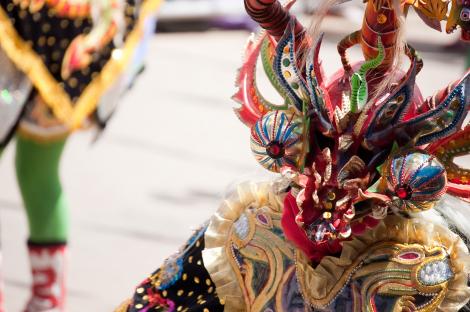Bolivia – festivals, parties, fiestas and customs
 by Kat Dougal on 23rd June, 2016
by Kat Dougal on 23rd June, 2016

Bolivia – festivals, parties, fiestas and customs
Many festivals are celebrated throughout the year in Bolivia. From the traditional to the more westernised, Bolivia’s festivals are full of great music and colourful displays.
The following is a list of some of the main events that each month takes place throughout the country; however at any time of year there will be some type of event to celebrate.
Dates can change, so when planning, be sure to get the latest information. Some of these Bolivian festivals are also national holidays.
Let us know about any of your favourites that we’ve missed!
JANUARY:
24th January: Alasitas Fair
A month-long festival, where locals purchase miniature items to give to Ekeko, the Aymara god of abundance, in the hope he will bring fortunate and happiness to their lives.
During the festival, La Paz is filled with market stalls lining the city’s many streets and parks. Vendors sell beautiful handcrafts such as ceramics and leather goods, as well as baked treats and dried fruits.

Llama foetus market, La Paz, Bolivia
FEBRUARY
24th February: Carnival in Oruro
Using a mix of dance, music and costume, Carnival not only tells the story of how the Spaniards conquered the Aymara and Quechua people of Bolivia, but celebrates good versus evil intertwined with Oruro’s rich cultural identity
MARCH
19th March: The Pujllay Festival of Tarabuco
Considered one of the most important indigenous festivities, Pujllay commemorates the defeat of the Spanish imperialist army at the hands of the native community in the battle of Jumbate, War of Independence of Bolivia.
During the ceremony, locals raise a tall wooden tower called the “pukara” which they cover in agricultural products as offerings to Pachamama to ensure the land is fertile for the next harvest. For hours, people dance around the pukara, playing local instruments such as pinkillos and Tokoros.

Lucky charm stall, Tarabuco, Bolivia.
APRIL
9th April: Holy Week in Sucre
Marked in Sucre by several processions, the height of the celebrations takes place on Holy Thursday. Churches throughout the city open their doors to devotees who light candles, pray and sing hymns.
MAY
25th May: Sucre, The First Cry for Freedom
Known as the “first cry for freedom”, this uprising became the first in a series of events that would see revolution spread quickly throughout the continent and the Latin American Wars of Independence begin.
Each year, Sucre marks the anniversary with parades and festivals with La Casa de la Libertad, where Bolivia was officially signed into existence, is a focal point for many of the celebrations.
JUNE
21st June: Amayra New Year.
Coinciding with the winter solstice, this is the start of the Aymaran year.
People flock from all over the world to watch the sun’s rays shine through the temple entrance at the Tiwanaku temple.
Locals wear colourful ceremonial clothing, drinking singani, chewing coca, sacrificing llamas and dancing until dawn. Tourists welcome.
JULY
31st July: San Ignacio de Moxos in Beni.
Festival dancers put on their best costumes and dance, in processions, for four days in honour of the Patron Saint San Ignacio, a statue of whom is periodically paraded through the streets.
Look out for midnight fireworks popping out from the top of their wide-brimmed hats, symbolizing the gift of light and vision.
AUGUST
6th August: Bolivia independence day
Independence Day, also known as Dia de la Patria, is a national holiday in Bolivia in honour of the Battle of Ayacucho.
Celebrations are held throughout the country – dancing, bull fights, military parades and marching bands in most major towns and cities.
SEPTEMBER
8th September: Virgen de Guadalupe.
The Virgin de Guadalupe is one of the most venerated saints in all of Latin America.
Sucre transforms into a voracious party zone featuring non-stop dancing, joyful music, delicious food and elaborate costumes, all in honour of Sucre’s patroness, the Virgin of Guadalupe.
NOVEMBER
2nd November: All Saints’ Day.
A combination of indigenous tradition and Catholic beliefs, a day in which Bolivian families gather to welcome the returning dead.
Celebrations begin at midday with a big feast to honour the departed and a place is set for them at the table. The shrine is laid out with photos of the deceased, religious objects and many of the deceased’s favourite foods and drinks. Drinks are served in a circle, with each person in turn inviting their neighbour to share a drink.
More festivals to look for:
Wayllunk’as de San Andrés
Fiesta de la Virgen de Urkupiña
Fiesta del Mar en el Titicaca
Festival Universitario
Fiestas de la Virgen de Guadalupe
Carnaval de la Concordia
Potosí de Fiesta
Carnaval de Tarija
Contact us for more about Bolivia holidays.
Share







